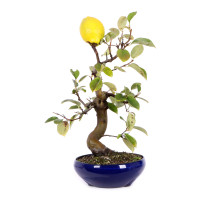Corylus avellana 'Rotblättrige Zellernuss'
Hazelnut 'Rotblättrige Zellernuss'
- Order number: 1914-P-25-0024
- Height: 35 cm (incl. pot)
- Foliage: deciduous
- Bonsai Pot: plastic pot
- Year: 2019
- Origin: Germany
Corylus avellana 'Rotblättrige Zellernuss' - Hazelnut 'Rotblättrige Zellernuss'
General:
The common hazel is native to Europe and western Asia. It grows here in sparse deciduous forests, at the edge of woods or in hedgerows. It usually forms several stems that spread widely when old. The leaves are roundish, dark green and turn yellow to yellow-orange in autumn. In spring, hazel blooms a delicate yellow long before the leaves emerge, sometimes as early as January. The yellow flowers are the male catkins. The fruits then ripen until September/October. By the way, the hazelnuts had an important meaning for humans already in the Middle Stone Age and are still intensively cultivated in countries like Turkey and Italy. However, the use of wood has lost its importance.
Care as a bonsai:
The hazel is very robust, vigorous and through regular pruning, a beautiful and dense branching is quickly formed. The branches can also be shaped well with wire but this must be removed in time to avoid scars on the smooth bark. With a strong pruning, the hazel also sprouts very well from the old wood and can thus be rejuvenated again and again. The hazel prefers a moist, well nutrient supplied soil and a sunny location. By the way, already at the age of five years the plants can bloom and form the typical hazelnut fruits.
Special features of the variety:
The 'Rotblättrige Zellernuss' has light to dark red leaves when budding, which turn dark green again by summer. Thus, with this hazelnut variety you already have a special play of colors within the bonsai collection in spring. Also the red flower and fruits are very decorative and the later developing nuts are edible as with the species.







































